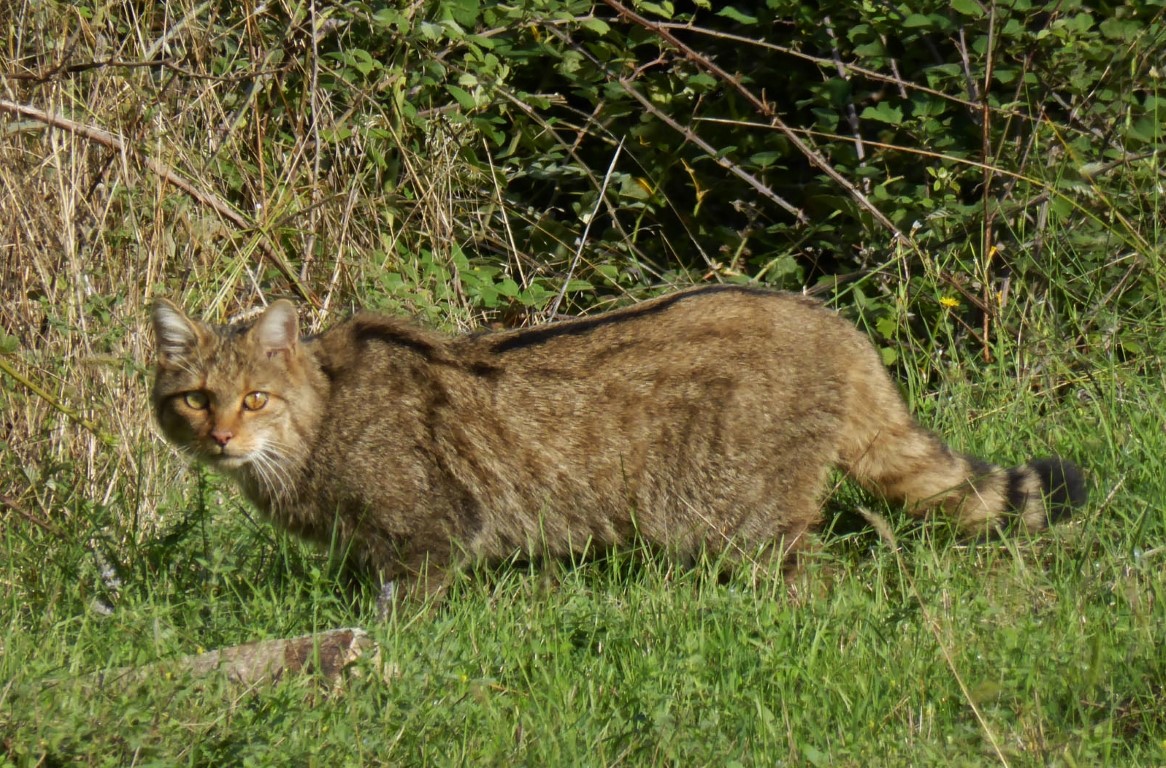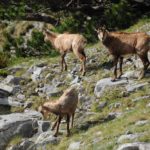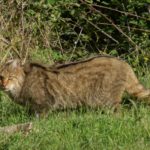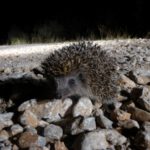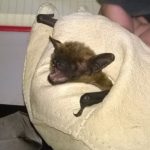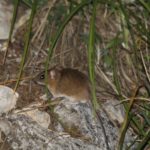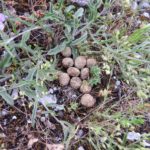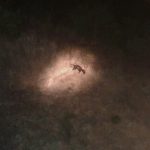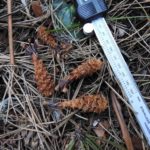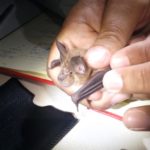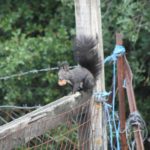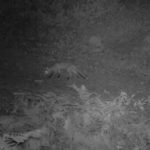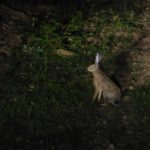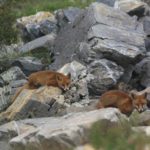Mammals
More than 40 species of mammals6,7,8 have been recorded on Olympus, the most common being the Balkan chamois (Rupicapra rupicapra balcanica), roe deer (Capreolus capreolus), stone marten (Martes foina), wild boar (Sus scrofa), fox (Vulpes vulpes), red squirrel (Sciurus vulgaris), wild cat (Felis sylvestris), and many species of bats (Barbastella barbastellus, Eptesicus serotinus, Plecotus kolombatovici, Pipistrellus pygmaeus). Large carnivores such as the brown bear (Ursus arctos) and the wolf (Canis lupus) are transient throughout the mountain and its foothills. The Balkan chamois is probably the most representative mammal associated with Mount Olympus, as it can be easily observed by hikers and visitors during the summer months in the alpine zone.
Among the mammals of Olympus, 20 species are included in the Habitat’s Directive 92/43/EEC, as well as a few endangered (EN) and vulnerable (VU) species from the Red Book of Endangered Animals of Greece9.
Gallery
Mammals included in the EU Directive 92/43/EE and the Red Book of Endangered Animals of Greece
| Α/Α | SPECIES | COMMON NAME | PROTECTION STATUS |
|---|---|---|---|
| 1 | Barbastella barbastellus | Barbastelle | Annex ΙΙ, ΕΝ |
| 2 | Canis lupus | Wolf | Annex IV, VU |
| 3 | Capreolus capreolus | Roe deer | VU |
| 4 | Eptesicus serotinus | Serotine bat | Annex IV |
| 5 | Felis silvestris | Wild cat | Annex IV |
| 6 | Hypsugo savii | Savi’s pipistrelle | Annex IV |
| 7 | Miniopterus schreibersii | Common bentwing / Schreiber’s bat | Annex ΙΙ |
| 8 | Myotis emarginatus | Geoffroy’s bat | Annex ΙΙ |
| 9 | Nyctalus lasiopterus | Greater noctule | Annex IV, VU |
| 10 | Nyctalus leisleri | Lesser noctule / Leisler’s bat | Annex IV |
| 11 | Pipistrellus kuhlii | Kuhl’s pipistrelle | Annex IV |
| 12 | Pipistrellus nathusii | Nathusius pipistrelle | Annex IV |
| 13 | Pipistrellus pipistrellus | Common pipistrelle | Annex IV |
| 14 | Pipistrellus pygmaeus | Soprano pipistrelle | Annex IV |
| 15 | Plecotus kolombatovici | Kolombatovic’s long-eared bat | Annex IV |
| 16 | Rhinolophus ferrumequinum | Greater horseshoe bat | Annex. ΙΙ |
| 17 | Rhinolophus hipposideros | Lesser horseshoe bat | Annex ΙΙ |
| 18 | Rupicapra rupicapra balcanica | Balkan chamois | Annex ΙΙ |
| 19 | Tadarida teniotis | European free-tailed bat | Annex IV |
| 20 | Ursus arctos* | Brown bear | Annex ΙΙ, ΕΝ |
| 21 | Vespertilio murinus | Parti-coloured bat | Annex IV |
Priority species of EU Directive 92/43/ΕE are denoted with an asterisk*.
ΕΝ= Endangered
VU= Vulnerable
a Priority habitats / Species: Natural habitats and species that are in danger of disappearance for the conservation of which the Community has particular responsibility in view of the proportion of their natural range which falls within its territory. They are denoted by an asterisk (*) in Annexes I and II and special measures apply to them.
b Annex I Habitat types of EU Habitat’s Directive 92/43/EEC: Natural habitat types of community interest whose conservation requires the designation of special areas of conservation.
c Annex II Species of EU Habitat’s Directive 92/43/EEC: Animal and plant species of community interest whose conservation requires the designation of special areas of conservation.
d Annex IV Species of EU Habitat’s Directive 92/43/EEC: Animal and plant species of community interest in need of strict protection.
e Annex Ι species of EU Wild Bird’s Directive 2009/147/ΕEC: Species that are subject to special conservation measures concerning their habitat in order to ensure their survival and reproduction in their area of distribution.
1 «Specialized Environmental Study of Olympus National Park» (2010). Ministry of Environment, Energy and Climate Change, Dept. of Environmental Planning, Division for the Management of the Natural Environment.
2 Tsitsoni Th., Fotiadis G., ELKE-AUTH (2015). «Surveillance and evaluation of the conservation status of Habitat Types of European Community Interest in the area of jurisdiction of Olympus National Park Management Agency». Phase D’. ONPMA, RDP Macedonia-Thrace 2007-2013.
3 Council Directive 92/43/EEC “On the Conservation of Natural Habitats and of Wild Fauna and Flora”.
4 Strid, A. (1980). Wild Flowers of Mount Olympus. Goulandri Natural History Museum, Athens.
5 Tsitsoni Th., Fotiadis G., Tsitinis G., ELKE-AUTH (2015). «Surveillance and evaluation of the conservation status of Plant species of European Community Interest in the area of jurisdiction of Olympus National Park Management Agency». Phase D’. ONPMA, RDP Macedonia-Thrace 2007-2013.
6 Sokos, Ch., Birtsas P., Hatzinikos E., Bontzorlos V., Papaspyropoulos, Κ., et al., TECHNOOMOIOSTASI-YLORIKI-LOUVITAKIS (2015). «Surveillance and evaluation of the conservation status of Mammals of European Community Interest in the area of jurisdiction of Olympus National Park Management Agency». Phase D’. ONPMA, RDP Macedonia-Thrace 2007-2013.
7 Olympus National Park Management Agency (2017). Technical Report 2016 on the Monitoring of Environmental Parameters, Litochoro.
8 Olympus National Park Management Agency (2016). Technical Report 2015 on the Monitoring of Environmental Parameters, Litochoro.
9 Legakis, A. & Maragou, P. (2009). The Red Book of Endangered Animals of Greece.Hellenic Zoological Society, Athens.
10 Bousbouras, D. & YETOS Ο.Ε. (2015). «Surveillance and evaluation of the conservation status of Birds of European Community Interest in the area of jurisdiction of Olympus National Park Management Agency». Phase D’. ONPMA, RDP Macedonia-Thrace 2007-2013.
11 Directive 2009/147/EC of the European Parliament and the Council of 30 November 2009 “On the Conservation of Wild Birds”.
12 Ioannidis I., Papamichail G., GEOANALYSIS Α.Ε. (2015) «Surveillance and evaluation of the conservation status of Amphibians & Reptiles of European Community Interest in the area of jurisdiction of Olympus National Park Management Agency». Phase D’. ONPMA, RDP Macedonia-Thrace 2007-2013.
13 Pamperis, L. (2009). The Butterflies of Greece. 2nd edition, PAMPERI & ΚΟΑΝ publishers, Athens. Website www.pamperis.gr for updates on the book.
14 Avtzis D., Kaltsas D., TECHNOOMOIOSTASI-YLORIKI-LOUVITAKIS (2015) «Surveillance and evaluation of the conservation status of Invertebrates of European Community Interest in the area of jurisdiction of Olympus National Park Management Agency». Phase D’. ONPMA, RDP Macedonia-Thrace 2007-2013.
15 Presidential Decree 67/1981 (Hellenic Government Gazette No. 23 Α’/30-1-1981) “On the protection of native flora and wild fauna and the procedures for the coordination and control of their research”.
16 Heath, J. (1981) Threatened Rhopalocera (butterflies) of Europe. Council of Europe.
17 Tolmann, T. & Lewington, R. (2008). Collins Butterfly Guide: The Most Complete Field Guide to the Butterflies of Britain and Europe. 3rd Edition, HarperCollins UK.
18 Speight M.C.D. (1989). Saproxylic invertebrates and their conservation. Council of Europe.


